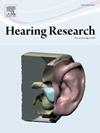听觉表型的多感官评估
IF 2.5
2区 医学
Q1 AUDIOLOGY & SPEECH-LANGUAGE PATHOLOGY
引用次数: 0
摘要
尽管越来越多的证据表明感觉丧失后神经和行为具有可塑性,但目前尚不清楚多感觉处理在临床听力损失表型中是如何变化的。本研究调查了不同程度听力损失和使用听力技术的成年人的视觉感知和视听(AV)整合。参与者包括听力正常(NH)、助听器(HA)使用者、人工耳蜗(CI)候选人和人工耳蜗使用者。为了评估视觉和多感觉加工,我们进行了视觉时间顺序判断(vTOJ)任务、McGurk错觉、单音节唇读任务和AV单词识别任务。结果显示,随着听力损失严重程度的增加,视觉时间分辨率有提高的趋势,尽管这与年龄相混淆。McGurk错觉反应表明,听力损失的存在降低了听觉权重,而听力损失的严重程度增加了视觉权重。随着听力损失的进展,读唇表现显著提高,CI使用者的表现优于所有其他组,这可能是由于在CI临床方案中使用了康复练习。相比之下,AV的益处不随听力损失而系统性变化,但显示出年龄的显著影响。综上所述,这些发现表明,视觉表现和视觉感觉重量——而不仅仅是视听整合本身——是由听力损失调节的。这些差异可能反映了负责处理多感觉输入的皮层区域的潜在可塑性。此外,这些发现强调了视觉任务在表征感觉表型和为听力损失患者提供临床决策信息方面的潜在效用。本文章由计算机程序翻译,如有差异,请以英文原文为准。
Multisensory assessment for hearing phenotypes
Despite growing evidence of neural and behavioral plasticity following sensory loss, it remains unclear how multisensory processing varies across clinical hearing loss phenotypes. This study investigated visual perception and audiovisual (AV) integration in adults with varying degrees of hearing loss and hearing technology use. Participants included individuals with normal hearing (NH), hearing aid (HA) users, cochlear implant (CI) candidates, and CI users. To assess visual and multisensory processing, we administered a visual temporal order judgment (vTOJ) task, the McGurk illusion, a monosyllabic lipreading task, and an AV word recognition task. Results revealed a trend toward improved visual temporal resolution with increasing hearing loss severity, though this was confounded by age. McGurk illusion responses indicated that the presence of hearing loss decreased auditory weighting, while the severity of hearing loss increased visual weighting. Lipreading performance significantly improved as hearing loss progressed, with CI users outperforming all other groups—possibly due to the use of rehabilitation exercises in the CI clinical protocol. In contrast, AV benefit did not vary systematically with hearing loss, but showed a significant effect of age. Together, these findings suggest that visual performance and visual sensory weighting—more than AV integration per se—are modulated by hearing loss. These differences may reflect underlying plasticity of the cortical regions responsible for processing multisensory input. Furthermore, these findings highlight the potential utility of visual tasks in characterizing sensory phenotypes and informing clinical decision-making for individuals with hearing loss.
求助全文
通过发布文献求助,成功后即可免费获取论文全文。
去求助
来源期刊

Hearing Research
医学-耳鼻喉科学
CiteScore
5.30
自引率
14.30%
发文量
163
审稿时长
75 days
期刊介绍:
The aim of the journal is to provide a forum for papers concerned with basic peripheral and central auditory mechanisms. Emphasis is on experimental and clinical studies, but theoretical and methodological papers will also be considered. The journal publishes original research papers, review and mini- review articles, rapid communications, method/protocol and perspective articles.
Papers submitted should deal with auditory anatomy, physiology, psychophysics, imaging, modeling and behavioural studies in animals and humans, as well as hearing aids and cochlear implants. Papers dealing with the vestibular system are also considered for publication. Papers on comparative aspects of hearing and on effects of drugs and environmental contaminants on hearing function will also be considered. Clinical papers will be accepted when they contribute to the understanding of normal and pathological hearing functions.
 求助内容:
求助内容: 应助结果提醒方式:
应助结果提醒方式:


